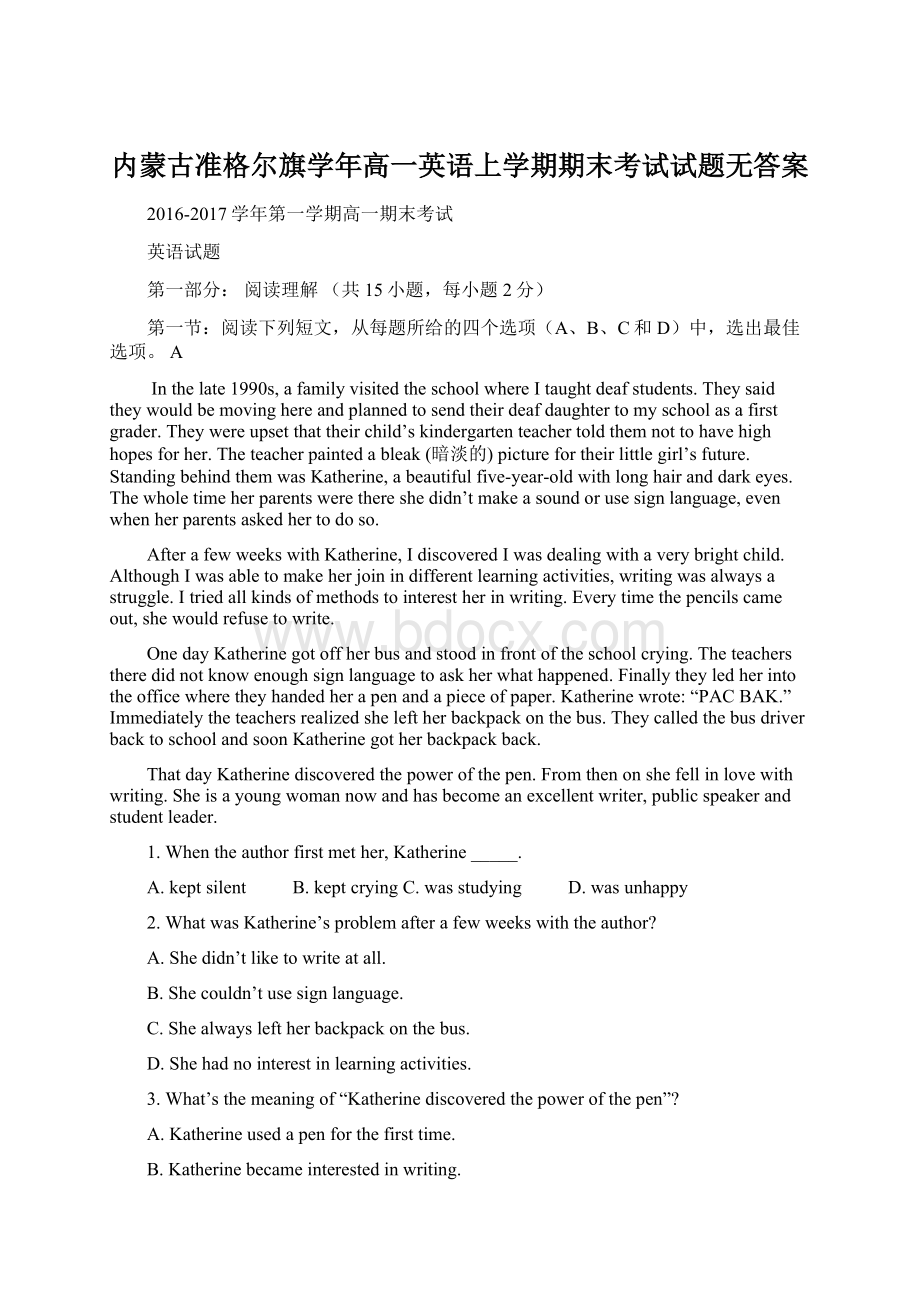内蒙古准格尔旗学年高一英语上学期期末考试试题无答案.docx
《内蒙古准格尔旗学年高一英语上学期期末考试试题无答案.docx》由会员分享,可在线阅读,更多相关《内蒙古准格尔旗学年高一英语上学期期末考试试题无答案.docx(8页珍藏版)》请在冰豆网上搜索。

内蒙古准格尔旗学年高一英语上学期期末考试试题无答案
2016-2017学年第一学期高一期末考试
英语试题
第一部分:
阅读理解(共15小题,每小题2分)
第一节:
阅读下列短文,从每题所给的四个选项(A、B、C和D)中,选出最佳选项。
A
Inthelate1990s,afamilyvisitedtheschoolwhereItaughtdeafstudents.Theysaidtheywouldbemovinghereandplannedtosendtheirdeafdaughtertomyschoolasafirstgrader.Theywereupsetthattheirchild’skindergartenteachertoldthemnottohavehighhopesforher.Theteacherpaintedableak(暗淡的)picturefortheirlittlegirl’sfuture.StandingbehindthemwasKatherine,abeautifulfive-year-oldwithlonghairanddarkeyes.Thewholetimeherparentswerethereshedidn’tmakeasoundorusesignlanguage,evenwhenherparentsaskedhertodoso.
AfterafewweekswithKatherine,IdiscoveredIwasdealingwithaverybrightchild.AlthoughIwasabletomakeherjoinindifferentlearningactivities,writingwasalwaysastruggle.Itriedallkindsofmethodstointerestherinwriting.Everytimethepencilscameout,shewouldrefusetowrite.
OnedayKatherinegotoffherbusandstoodinfrontoftheschoolcrying.Theteacherstheredidnotknowenoughsignlanguagetoaskherwhathappened.Finallytheyledherintotheofficewheretheyhandedherapenandapieceofpaper.Katherinewrote:
“PACBAK.”Immediatelytheteachersrealizedsheleftherbackpackonthebus.TheycalledthebusdriverbacktoschoolandsoonKatherinegotherbackpackback.
ThatdayKatherinediscoveredthepowerofthepen.Fromthenonshefellinlovewithwriting.Sheisayoungwomannowandhasbecomeanexcellentwriter,publicspeakerandstudentleader.
1.Whentheauthorfirstmether,Katherine_____.
A.keptsilent B.keptcryingC.wasstudying D.wasunhappy
2.WhatwasKatherine’sproblemafterafewweekswiththeauthor?
A.Shedidn’tliketowriteatall.
B.Shecouldn’tusesignlanguage.
C.Shealwaysleftherbackpackonthebus.
D.Shehadnointerestinlearningactivities.
3.What’sthemeaningof“Katherinediscoveredthepowerofthepen”?
A.Katherineusedapenforthefirsttime.
B.Katherinebecameinterestedinwriting.
C.Katherineunderstoodhowtousethepen.
D.Katherineknewwhatthepenwasusedfor.
B
WhenIwas8yearsold,Idecidedtorunawayfromhomeafteraquarrelwithmymother.Withmysuitcasepackedandsomesandwichesinabag,Istartedforthefrontdoor.
MymomaskedwhereIwasgoing.“I’mleavinghome,”Isaid.
“What’sthatyou’recarrying?
”sheasked.
“Someclothesandfood,”Ireplied.
“Ifyouwanttorunaway,that’sallright,”shesaid.“Butyoucameintothishomewithoutanythingandyoucanleavethesameway.”
Ithrewmysuitcaseandsandwichesonthefloorandstartedforthedooragain.
“Waitaminute,”Momsaid.“Youdidn’thaveanyclothesonwhenyouarrived,andIwantthemback.”
Thisinfuriatedme.Itoremyclothesoff—shoes,socks,underwearandall—andshouted,“CanIgonow?
”
“Yes,”mymomanswered,“butonceyouclosethatdoor,don’texpecttocomeback.”
IwassoangrythatIshutthedoorforcefullyandsteppedoutofmyhome.ThenInoticeddownthestreettwoneighborgirlswalkingtowardourhouse.IwassoshythatIsawthebigspruce(云杉)treeinouryardandjumpedunderthelow-hangingbranches(树枝).Apileofdried-upbrownneedles(针状物)werebeneaththetree,andyoucan’timaginethepainthosesharpneedlescausedtomybody.
AfterIwassurethegirlshadpassedby,Irantothefrontdoorandknockedatitloudly.
“It’sBilly!
Letmein!
”
Thevoicebehindthedooranswered,“Billydoesn’tlivehereanymore.Heranawayfromhome.”
Lookingbehindmetoseeifanyoneelsewascomingdownthestreet,Isaid,“Mom!
I’msorry.I’mstillyourson.Letmein!
”
ThedooropenedandMom’ssmilingfaceappeared.“Didyouchangeyourmindaboutrunningaway?
”sheasked.
“What’sforsupper?
”Ismiledback.
4.Whentheauthorwasleavinghome,hismotherorderedhimto_____.
A.stayathomeB.takesomesandwiches
C.leaveeverythingbehindD.checkhissuitcasecarefully
5.Whichofthefollowingcanbestdescribetheauthor’smom?
A.Selfishandproud. B.Strictbutloving.
C.Kindandhelpful. D.foolishbutpatient.
6.Theunderlinedword“infuriated”probablymeans“_____”.
A.surprised B.warned C.encouraged D.angered
7.Whydidtheauthorjumpunderthelow-hangingbranches?
A.Toavoid(避免)beingseen.B.Tofindsomeneedles.
C.Toplayajokeonthetwogirls.D.Toattract(吸引)thetwogirls’attention.
8.Thelastsentence“What’sforsupper?
”mainlyshowsthattheauthor_____.
A.feltveryhungryatthattime
B.changedhisplantoleavehome
C.wishedtoeatsomethingbeforeleaving
D.wantedtoknowwhathismotherpreparedforsupper
C
GeorgeWatfordworksattheAmericanSocietyforthePreventionofCrueltytoAnimals(ASPCA)inNewYorkCity.Hegetssomeunusualphonecalls.Oneday,hegotacallaboutamountainlionlivinginasmallbuilding.“Wedidn’tbelieveit,”Watfordsaid.“Butwhenwewentoutthere,sureenough,therewasamountainlionsittingatthefrontwindowlookingoutatus.”Thebigcat’sownerknewthathisneighborswereunhappyabouttheanimal.Hedidn’ttrytostopustakingitaway.
Inoneyear,theASPCAtookin9,459differentanimals,notcountingcatsanddogs.Thatnumberincludesalotofrabbitsandmonkeys,buttheASPCAhasalsotakenmanyotherexotic(外来的)petsfrompeople’shomes.Theseanimalscan’tbesetfreeintothewildbecausetheywouldn’tsurvive.TheASPCAtriestofindhomesfortheminzoosorspecialareasforanimals.
It’sagainstthelawtosellwildanimalsinNewYorkCity.Manybuildingsdon’tevenallowdogsandcats,nottomentionmoreexoticanimals.Still,theASPCAtakesawaymostoftheexoticanimalsnotbecauseofcomplaints(怨言),butbecausethepet’sownerneedshelp.Alovelybabylionorbearwillfinallygrowuptobedangerous.“Whentheybite(咬人),itisn’tbecausetheyhateyou.It’sbecausethey’rewildanimals,”saidexoticanimalexpertKathiTravers.
Traversisquicktogivespeechesagainstraisingwildanimalsaspets.Toooftenpeoplethinkthatcaringforawildanimalisthesameascaringforadogoracat.“Toloveananimalisnotenough,”Traverssaid.“Therehastoberespect(尊重),andrespectisnottakingananimal,stickingitinalittlecage,andexpectingtheanimaltobehappy.”
9.Thecallwasmade_____.
A.toreportamissinglionB.toreportaneighborforkeepingalion
C.whentheownerwasawayD.whenthelionbrokeoutofthewindow
10.Whenitfindsanexoticanimalinthecity,theASPCA_____.
A.keepsituntilitgrowsupB.setsitfreeintothewild
C.helpsfinditahomeD.sellsittoazoo
11.Thelastparagraphiswrittentoshowthat_____.
A.ittakesefforttocareforawildanimal
B.keepingwildanimalsaspetsisunwise
C.wildanimalsarehappyinbigspaces
D.wildanimalscanbedangerous
D
Newbornsbegintodeveloplanguageskillslongbeforetheybeginspeaking.And,comparedtoadults,theydeveloptheseskillsmorequickly.Peoplehaveahardtimelearningnewlanguagesastheygrowolder,butbabieshavetheabilitytolearnanylanguageeasily.
Foralongtime,scientistshavetriedtoexplainhowsuchyoungchildrencanlearnthecomplicated(复杂的)grammaticalrulesandsoundsofalanguage.Now,researchersaregettingabetterideaofwhat’shappeninginthebrainsofthetiniestlanguagelearners.Thisnewinformationmighthelpkidswithlearningproblemsaswellasadultswhowanttolearnnewlanguages.Itmightevenhelpscientistswhoaretryingtodesigncomputersthatcancommunicatelikepeopledo.
Mostbabiesgo“mama”by6monthsofage,andmostchildrenspeakinfullsentencesbyage3.Formanyyears,scientistshavewonderedhowthebrainsofyoungchildrenfigureouthowtocommunicateusinglanguage.Withhelpfromnewtechnologies,scientistsarenowfindingthatbabiesbeginlifewiththeabilitytolearnanylanguage.Theygetintocontact(接触)withotherpeople,listentowhattheysayandwatchtheirmovementsveryclosely.Thatiswhytheyquicklymasterthelanguagestheyhearmostoften.
Studiesshowthat,uptoabout6monthsofage,babiescanrecognizeallthesoundsthatmakeupallthelanguagesintheworld.Startingataround6monthsoldababy’sbrainfocuseson(集中于)themostcommonsoundsithears.Then,childrenbeginrespondingonlytothesoundsofthelanguagetheyhearthemost.
Inasimilarwayolderbabiesstartrecognizingthepatternsthatmakeuptherulesoftheirnativelanguage.Forexample,Englishchildrenwhoareabout18monthsoldstarttofigureoutthatwordsendingin“-ing”or“-ed”areusuallyverbs,andthatverbsareactionwords.
12.Whichofthefollowingopinionsdoestheauthoragreewith?
A.Babiesarereallygoodlanguagelearners.
B.Adultsshouldlearnlanguageslikebabies.
C.It’sbettertolearnanewlanguageatanearlyage.
D.Babiesshouldbetrainedtoimprovelanguageskills.
13.Thenewresearchinthesecondparagraphcanbehelpfulin_____.
A.findingsuccessfullanguagelearners
B.teachingkidswithlearningproblems
C.designinghuman-shapedcomputers
D.improvingbabies’languageability
14.Theresearchersfoundoutthatbabieslearnalanguagemainlyby_____.
A.repeatingthewordsofotherpeople
B.rememberingthefullsentencestheyhear
C.hearingandcloselywatchingothersspeak
D.figuringoutthemeaningofdifferentsounds
15.Inthelastparagraph,theauthorexplains_____.
A.whybabiespaymoreattentiontosounds
B.howbabiesrespondtowhattheyhearmostoften
C.whyverbsinalanguageattractthemostattentionofababy
D.howbabiesmasterthegramm